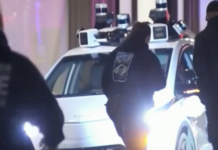As the staging ground for an assault on the Ukrainian capital of Kyiv, the Chernobyl Exclusion Zone, one of the most toxic places on earth, was probably not the best choice. But that did not seem to bother the Russian generals who took over the site in the early stages of the war.
“We told them not to do it, that it was dangerous, but they ignored us,” Valeriy Simyonov, the chief safety engineer for the Chernobyl nuclear site, said in an interview.
Apparently undeterred by safety concerns, the Russian forces tramped about the grounds with bulldozers and tanks, digging trenches and bunkers — and exposing themselves to potentially harmful doses of radiation lingering beneath the surface.
In a visit to the recently liberated nuclear station, site of the world’s worst nuclear disaster in 1986, wind blew swirls of dust along the roads, and scenes of disregard for safety were everywhere, though Ukrainian nuclear officials say no major radiation leak was triggered by Russia’s monthlong military occupation.
At just one site of extensive trenching a few hundred yards outside the town of Chernobyl, the Russian army had dug an elaborate maze of sunken walkways and bunkers. An abandoned armored personnel carrier sat nearby.
The soldiers had apparently camped out for weeks in the radioactive forest. While international nuclear safety experts say they have not confirmed any cases of radiation sickness among the soldiers, the cancers and other potential health problems associated with radiation exposure might not develop until decades later.
Mr. Simyonov said that the Russian military had deployed officers from a nuclear, biological and chemical unit, as well as experts from Rosatom, Russia’s state nuclear power company, who consulted with the Ukrainian scientists.
But the Russian nuclear experts seemed to hold little sway over the army commanders, he said. The military men seemed more preoccupied with planning the assault on Kyiv and, after that failed, using Chernobyl as an escape route to Belarus for their badly mauled troops.
“They came and did whatever they wanted” in the zone around the station, Mr. Simyonov said. Despite efforts by him and other Ukrainian nuclear engineers and technicians who remained at the site through the occupation, working round-the-clock and unable to leave except for one shift change in late March, the entrenching continued.
The earthworks were not the only instance of recklessness in the treatment of a site so toxic it still holds the potential to spread radiation well beyond Ukraine’s borders.
In a particularly ill-advised action, a Russian soldier from a chemical, biological and nuclear protection unit picked up a source of cobalt-60 at one waste storage site with his bare hands, exposing himself to so much radiation in a few seconds that it went off the scales of a Geiger counter, Mr. Simyonov said. It was not clear what happened to the man, he said.
The most concerning moment, Mr. Simyonov said, came in mid-March, when electrical power was cut to a cooling pool that stores spent nuclear fuel rods that contain many times more radioactive material than was dispersed in the 1986 catastrophe. That raised the concern among Ukrainians of a fire if the water cooling the fuel rods boiled away, exposing them to the air, though that prospect was quickly dismissed by experts.
As they retreated from Chernobyl, Russian troops blew up a bridge in the exclusion zone and planted a dense maze of anti-personnel mines, trip wires and booby traps around the defunct station. Two Ukrainian soldiers have stepped on mines in the past week, according to the Ukrainian government agency that manages the site.
In a bizarre final sign of the unit’s misadventures, Ukrainian soldiers found discarded appliances and electronic goods on roads in the Chernobyl zone. These were apparently looted from towns deeper inside Ukraine and cast off for unclear reasons in the final retreat. Reporters found one washing machine on a road shoulder just outside the town of Chernobyl.
Source : Nytimes














